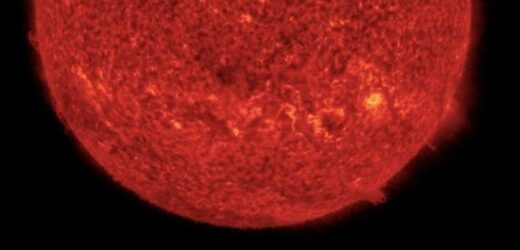NASA Solar Observatory captures solar flares in October
We use your sign-up to provide content in ways you’ve consented to and to improve our understanding of you. This may include adverts from us and 3rd parties based on our understanding. You can unsubscribe at any time. More info
Debris from the blast made up the core of a coronal mass ejection (CME), a large expulsion of plasma and magnetic field from the Sun’s corona, that was captured by NASA’s STEREO-A spacecraft and the Solar and Heliospheric Observatory (SOHO) in a stunning image. Now, experts saw the CME snapped by NASA and SOHO could deliver a ”glancing blow” to the Earth’s magnetic field on November 28.
According to the US Space Weather Prediction Center (SWPC), CMEs can reach the planet at speeds between 250 km per second and 3,000 km per second.
CME’s can also push geomagnetic storms straight into contact with Earth.
Astronomers at SpaceWeather.com explained: “A geomagnetic storm is a major disturbance of Earth’s magnetosphere that occurs when there is a very efficient exchange of energy from the solar wind into the space environment surrounding Earth.
“These storms result from variations in the solar wind that produces major changes in the currents, plasmas, and fields in Earth’s magnetosphere.
And this is not the first time the Sun’s wild activities has been snapped by the space agency.


Earlier this month, NASA images snapped by the space agency’s Solar Dynamics Observatory (SDO) revealed a large “coronal hole” in the Sun’s outer atmosphere which released “gaseous material” escaping this hole.
That time, there were fears that solar winds, which are streams of plasma that flow from the Sun’s corona into space, were going to strike the Earth.
But this time, there are fears that a CME will push a geomagnetic storm towards our planet.
Geomagnetic storms, if they collide with the Earth’s atmosphere, can cause chaos down below.
Ranked from G1 Minor to G5 Extreme, even the lowest intensity storm can cause havoc if it comes into contact with a satellite.

While the lower intensity storms can cause disturbances to satellite operations and power grid fluctuations, a stronger storm can result in power outages and major disruption to communications networks.
But luckily for Earth, solar activity has been very low over the past 24 hours, according to the Met Office’s space weather forecast.
And the SWPC has said it is not currently predicting any noticeable geomagnetic unrest over the next three days.
DON’T MISS
Archaeology breakthrough: 13-year-old makes 1300BC hoard discovery [REVEAL]
Maya breakthrough with incredible underwater find [INSIGHT]
La Palma volcano warning: ‘Unstoppable’ lava clocked at record speeds [REPORT]


And on the brighter side, lower intensity geomagnetic storms can also be accompanied by extraordinary auroras.
This includes the famous aurora borealis, also known as the Northern Lights, which can sometimes even be spotted from the UK during a solar storm.
Earlier this month, a G3-level geomagnetic storm brought stunning views of an aurora to skies across the world.
Source: Read Full Article


